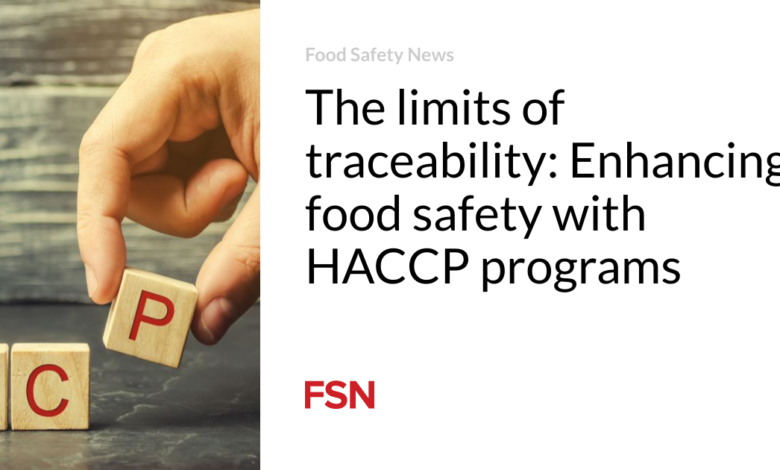The limits of traceability: Enhancing food safety with HACCP programs

For food and beverage processors, safety and quality are top priorities. To help prevent foodborne illnesses and protect consumers, traceability systems can track the production, processing, and distribution of products across the entire supply chain.
From farm to fork, tracking where a product originated and the steps it took before reaching the consumer can enable quicker identification and response to food safety issues. The more detailed the tracking record, the more likely the system is to isolate contamination sources and highlight gaps in a processor or supplier’s safety practices, allowing for targeted recalls and reducing the risk of additional unsafe foods reaching the market. These measures help hold manufacturers accountable to meeting product specifications and regulations.
The challenges of food traceability
While traceability in food supply chains is essential for identifying the origins of outbreaks and boosting consumer confidence, it doesn’t guarantee a safer food supply. Its effectiveness wholly depends on the accuracy of the data being collected. This requires every employee in the food processing chain to be fully aligned with the program. If some workers lack a clear understanding of the program or are not given the appropriate resources, the traceability system can become inconsistent, unreliable, or incomplete.
Traceability should also extend beyond the processing facility to include agricultural production, distribution, storage, and retail. For instance, if a refrigerated or frozen product is transported in a temperature-controlled truck that malfunctions, causing the product to thaw, it’s vital that the failure is traceable. Without proper tracking after the product leaves a processing facility, the processor cannot address quality issues that may arise down the line.
Additionally, traceability can become more complex for processors that source product from multiple suppliers. Since there is no standardization for how product traceability programs are conducted, it can be difficult to maintain consistency. Even processors in the same sector of the food industry can have vastly different programs for tracking these products.
Strengthening food safety with HACCP programs
Beyond merely tracing contamination, proactive measures like Hazard Analysis Critical Control Point (HACCP) programs are key to reducing the risk of foodborne illness from pathogenic organisms and other safety hazards across various sources. HACCP programs systematically work to identify, evaluate, and control potential biological, allergen, chemical, and physical hazards in the food. This framework can include a processor’s sanitation program, allergen control, training, supplier management, product labeling processes, and more—all of which are critical to monitoring and preventing the risks and hazards in food production.
A HACCP program begins with risk assessment to identify potential hazards in both the product and the processing environment. Temperature control, for instance, is a crucial critical control point because bacteria can grow rapidly between 40 and 140 degrees Fahrenheit. Keeping food properly refrigerated or frozen can help slow bacterial growth, but once thawed or left at room temperature, bacteria can begin to multiply to levels that may lead to foodborne illness.
In the case of physical hazards, metal detectors often serve as critical control points, identifying foreign objects that could contaminate food so they can be flagged and evaluated. Metallic contaminants can be introduced at various stages of processing and cause consumers immediate injury if not caught, so inspection throughout the process and at the end of the line is crucial.
Physical contaminants can come from external sources or internal ones, such as bone fragments in meat products. Similarly, chemical contamination could occur naturally from contaminants in the environment, or they could be artificially introduced during processing. Given the vast number of ways risks can be introduced, thorough risk assessment by the processor is crucial. Once all potential hazards are identified, the appropriate critical control points can be implemented to ensure a safe product reaches the consumer.
HACCP and traceability: A unified approach to food safety
Just as traceability alone doesn’t guarantee perfection, several factors can impact the successful implementation of a HACCP program. Like traceability, program ownership is critical. It must be managed by individuals who understand the complexity of the system and the potential hazards that could affect the final product. If a facility is experiencing a period of high employee turnover or struggles with inadequate training, it can hinder adherence to these stringent protocols. A successful HACCP plan requires full buy-in from all levels of an organization, from management to line workers. Without that support, a HACCP program can fail.
HACCP and traceability complement each other in managing food safety. As part of taking all the necessary precautions to identify and prevent hazards in the food supply, you will also need to be able to trace where a breakdown occurs if a hazard does reach the public. In fact, the documentation gathered under HACCP is often the same data that supports traceability efforts during a recall or other food safety incident.
The food and beverage industries have seen how recalls can erode consumer trust and compromise safety. In contrast, processors with a strong food safety plan that includes a powerful HACCP plan and traceability program demonstrate a commitment to safety and consumer well-being. Brands that are transparent about these efforts can build further trust with the public, strengthening their reputation and consumer loyalty.

About the author: Stephanie Sparks is Senior Field Microbiologist and Sector Specialist at Diversey Food and Beverage. She is a sector specialist and senior field microbiologist with 28 years of microbiology, auditing, and sanitation experience. FSPCA, HACCP, SQF, and ISO 22000 certified, Stephanie has experience in several food manufacturing industries including RTE, Beverage, Dairy, Processed Foods, Meat-Harvesting and Further Processing. She is also a member of the International Association of Food Protection and the International Society of Beverage Technologists.
(To sign up for a free subscription to Food Safety News,click here)



